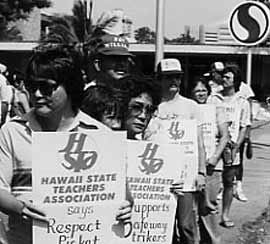
|

雇用
- 社会保障と退職
- 退職年齢と社会保障
- 家で仕事をする人々
- 長くなっている退職後の人生
- 雇用傾向
- アメリカ国内の外国人労働者
- アメリカにおけるメキシコ人労働者
- 労働安全基準
- 職場における負傷や死亡
- 大規模企業農場の発展
- アメリカの労働組合組織率
- 働く女性に関する法律
- アメリカにおける労働協約
- 労働権法
- アメリカにおける公務員労働組合
- 失業保険
- 雇用機会の均等に関する法律
- 労働者の補償
- 農業雇用における最低年齢
- 職場における未成年者
- 最低賃金
- 障害者の雇用
- アメリカにおける主な雇用機会均等に関する法律
- サービス産業における雇用
- 失業
- 州独自の労働者補償法
- 失業中の生活
- 最低賃金と貧困
|

In the 1980s, members of the Hawaii State
Teachers Association supported striking Safeway
workers.
Photo Courtesy of the United States Bureau of Labor Statistics
Union Membership Across the United States
The rate of union membership in the United States has declined steadily since 1983 when it peaked at 20.1%. Today it is a little over 13%. Some blame foreign competition for the loss of union jobs in the industrial sector, especially the steel and automotive industries. Automation also eliminated the need for some workers on assembly lines. In addition, many companies, located in states where unions were powerful, moved their factories to states that had right-to-work laws and few unions. Hawaii, New York, Alaska, New Jersey, and Michigan had the highest rate of union membership--over 20%-- in 2002.
|
言葉の説明:
right-to-work laws
|
rate of union membership
|
| ポッドキャスト ダウンロード:
英語
| 日本語
|
|
文書 |
ビデオクリップ |
図表 |
写真 |
地図
|
|

